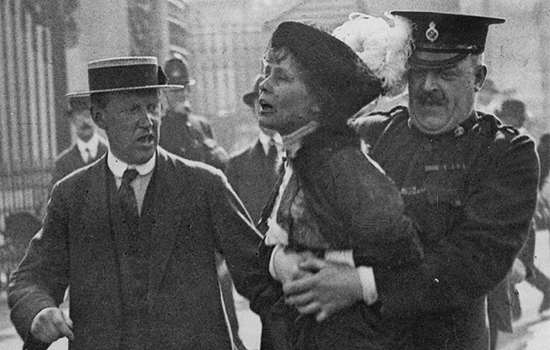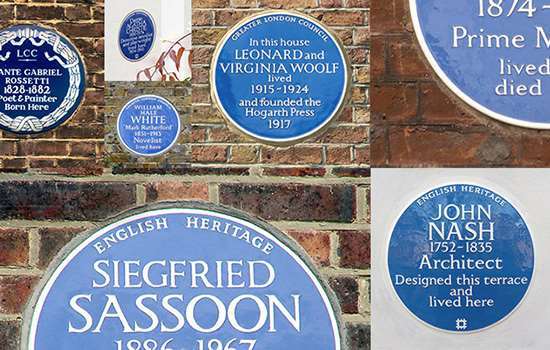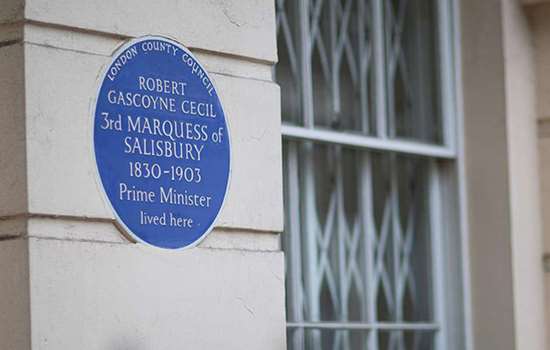FIRBANK, Ronald
Plaque erected in 2023 by English Heritage at 33 Curzon Street, Mayfair, London, W1J 7TR, City of Westminster
All images © English Heritage
Profession
Novelist
Category
Literature
Inscription
RONALD FIRBANK 1886–1926 Novelist lived here
Material
Ceramic
The novelist Ronald Firbank, known for his works that explore sexuality, social climbing and religion, has had a significant influence over many writers, including Evelyn Waugh, Angela Carter and Alan Hollinghurst. He is recognised with a blue plaque at 33 Curzon Street in Mayfair, one of the many London addresses that he occupied over the course of his short lifetime.
Early Life
Arthur Annesley Ronald Firbank was born in 1886 in London and brought up in Chislehurst, then in Kent. By the time he started at Trinity Hall, Cambridge, in 1906 he was already (at his own expense) a published writer of fiction. His first book, containing two stories, Odette d’Antrevernes and A Study in Temperament, came out in 1905 under the name Arthur Firbank. It showed the influence of Oscar Wilde, which would also be evident in his later works.
At Cambridge Firbank took an interest in drama and began to cultivate a dandyish appearance. A contemporary noted that ‘being so staringly marked a personality, there were people who couldn’t bear the sight of him’. Another, Oscar Wilde’s son Vyvyan Holland, later recounted that Firbank ‘never took exercise … never worked … never sat for any examination’.
After leaving Cambridge in 1909, Firbank adopted a nomadic lifestyle living in France, Spain, Italy, the Middle East and North Africa – where his homosexuality was less of a social and legal liability – interspersed with regular spells in London.
Literary Works
His first work as ‘Ronald Firbank’ was Vainglory (1915). He followed this with Inclinations (1916), Caprice (1917) and Valmouth (1919), each in a similar vein of oblique social satire on English life conveyed in baroque and playful prose, and each featuring lesbian themes.
Firbank’s travels were a palpable influence on his later work. A play, The Princess Zoubaroff (1920), was set in Italy, the novella Santal (1921) tracked an Arab boy’s search for spirituality, while The Flower Beneath the Foot (1923) was set in a Balkan country’s court. Wider recognition for Firbank came with Sorrow in Sunlight (1924), which tells of the ill-fated social climbing of a black Caribbean family.
Firbank died, just 40 years old, at the Hotel Quirinale in Rome on 21 May 1926. The cause of death was lung disease, certainly exacerbated by his drinking habits. Such a sudden death, abroad and alone, sparked rumours that Firbank was not dead but had gone to South Africa or entered a monastery.
His posthumously published novels include Concerning the Eccentricities of Cardinal Pirelli (1926) and The Artificial Princess (1934), on which he had worked before the First World War. Firbank’s last work, the New York-set The New Rythum, was published in fragmentary form in 1962.
Critical Reception
Firbank’s works have garnered mixed reactions both during his lifetime and after. The Yorkshire Post (11 October 1916) damned Inclinations as ‘ragtime fiction’ and ‘no manly accomplishment’. Frivolity has been the main complaint of critics, but over time there has been greater appreciation of his camp ‘Firbankian’ humour and his overt queerness.
In the preface to The Works of Ronald Firbank (1929), the critic and sinologist Arthur Waley hailed Firbank as ‘the first and almost the only Impressionist in English fiction, the earliest writer to discard the load of realistic lumber under which the modern story is interred’. Evelyn Waugh described him as ‘a figure of essential artistic integrity and importance’ and Cyril Connolly called him a ‘genuine innovator’.
Other writers to acknowledge their debt to him as a pioneering modernist and a writer (who was as openly gay as it was then possible to be) include EM Forster, Anthony Powell, Ivy Compton-Burnett, Joe Orton, Muriel Spark and Simon Raven.
London Life
Despite his constant travelling Firbank retained a strong connection to London and spent part of almost every one of his adult years there. With his mother, Harriette (known as ‘Baba’), he lived at 33 Curzon Street in Mayfair from around early 1911. He was there less than two years – though by Firbank’s standards this was a longish connection. He still found time to make trips to Lisbon, Egypt, Constantinople (now Istanbul) and Athens during this period.
At this time he adopted the name Ronald Firbank and began to develop the persona to match. When in London, he started to frequent his favourite haunts: the Café Royal, the Tour Eiffel restaurant in Fitzrovia, the theatre and the Russian Ballet. He became what his friend Evan Morgan described as a ‘unique character of cameo fantasy’, drifting without aim, skirting Covent Garden to avoid the ‘massacre of flowers’, and holding a handkerchief to his face whenever he passed a butcher’s shop. Firbank’s London-set fiction strongly evokes the time and place in which he lived: a 1918 review of Caprice in The Globe noted that it contained the best description of the Café Royal in any fiction.
It was during Firbank’s time in Curzon Street that he and Vyvyan Holland arranged to visit the novelist Ada Leverson. Firbank wore a large silk hat and, as Holland tells it, ‘the most remarkable pair of trousers then in existence’, in mauve and black stripes. Despite their having an appointment, a servant told them that Leverson was not in. Firbank ascribed this snub to his outfit, and ‘seized the first hansom that passed and drove back to Curzon Street, where he removed the trousers and cut them up into small pieces, which he fed to his bedroom fire.’
Further Reading
- Brigid Brophy, Prancing Novelist: A Defence of Fiction in the form of a Critical Biography in Praise of Ronald Firbank (London, 1973)
- Ifan Kyrle Fletcher, Ronald Firbank (London, 1930)
- Ronald Firbank, Oxford Dictionary of National Biography (Oxford, 2008) (public library subscription required)


